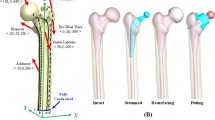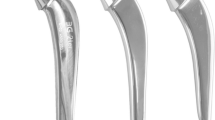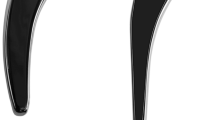Abstract
Introduction
Undersizing of cementless hip stems is a risk factor for aseptic loosening and early subsidence. The purpose of this study was to evaluate the effects of undersized stems and determine whether a biomechanical study can predict the clinical results.
Materials and methods
Three consecutive sizes of a clinically proven stem (CLS Spotorno) were implanted into six composite femora (size large, Sawbones®), respectively. According to the Canal Fill Index (CFI), two stems (size 11.25 and 12.5) were undersized (CFI < 80%) and one stem (size 13.75) had an appropriate size (CFI > 80%). The primary stability was evaluated by measurement of 3-dimensional (3D)-micromotions under physiological adapted load and surface strains were recorded before and after implantation to detect stress-shielding processes.
Results
Both undersized stems revealed significantly higher micromotions in all regions compared to the appropriate stem. The highest micromotions were registered at the distal tip of the three stem sizes. The changes in surface strain did not show a significant difference between the three stem sizes, but the highest strain reduction was observed proximally indicating a tendency for stress shielding.
Conclusions
This study confirms the clinical assumption that undersized stem result in a significantly reduced primary stability. Furthermore, in vitro studies allow to determine the effects of undersizing and stress shielding processes.




Similar content being viewed by others
References
Cherian JJ, Jauregui JJ, Banerjee S et al (2015) What host factors affect aseptic loosening after THA and TKA? Clin Orthop Relat Res 473(8):2700–2709
Holt G, Murnaghan C, Reilly J, Meek RM (2007) The biology of aseptic osteolysis. Clin Orthop Relat Res 460:240–252
Buckwalter AE, Callaghan JJ, Liu SS et al (2006) Results of Charnley total hip arthroplasty with use of improved femoral cementing techniques. a concise follow-up, at a minimum of twenty-five years, of a previous report. J Bone Jt Surg Am 88(7):1481–1485
Rasquinha VJ, Ranawat CS, Dua V et al (2004) A prospective, randomized, double-blind study of smooth versus rough stems using cement fixation: minimum 5-year follow-up. J Arthroplast 19(7 Suppl 2):2–9
Malchau H, Wang YX, Kärrholm J, Herberts P (1997) Scandinavian multicenter porous-coated anatomic total hip arthroplasty study. J Arthroplast 12:133–148
Aldinger PR, Jung AW, Breusch SJ et al (2009) Survival of the cementless Spotorno stem in the second decade. Clin Orthop Relat Res 467(9):2297–2304
Engh CA, Massin P (1989) Cementless total hip arthroplasty using the anatomic medullary locking stem. Results using a survivorship analysis. Clin Orthop Relat Res 249:141–158
Evola FR, Evola G, Graceffa A et al (2014) Performance of the CLS Spotorno uncemented stem in the third decade after implantation. Bone Jt J 96-B(4):455–461
Hwang KT, Kim YH, Kim YS, Choi IY (2012) Total hip arthroplasty using cementless grit-blasted femoral component: a minimum 10-year follow-up study. J Arthroplast 27(8):1554–1561
Streit MR, Innmann MM, Merle C et al (2013) Long-term (20- to 25-year) results of an uncemented tapered titanium femoral component and factors affecting survivorship. Clin Orthop Relat Res 471(10):3262–3269
Kim YH, Kim VE (1993) Early migration of uncemented porous coated anatomic femoral component related to aseptic loosening. Clin Orthop Relat Res 295:146–155
Nam D, Sauber TJ, Barrack T et al (2015) Radiographic parameters associated with pain following total hip and surface arthroplasty. J Arthroplast 30(3):495–501
Laine HJ, Pajamäki KJ, Moilanen T, Lehto MU (2001) The femoral canal fill of two different cementless stem designs. The accuracy of radiographs compared to computed tomographic scanning. Int Orthop 25(4):209–213
Laine HJ, Puolakka TJ, Moilanen T et al (2000) The effects of cementless femoral stem shape and proximal surface texture on ‘fit-and-fill’ characteristics and on bone remodeling. Int Orthop 24(4):184–190
Gheduzzi S, Miles AW (2007) A review of pre-clinical testing of femoral stem subsidence and comparison with clinical data. Proc Inst Mech Eng H 221(1):39–46
Bieger R, Ignatius A, Reichel H, Dürselen L (2013) Biomechanics of a short stem: in vitro primary stability and stress shielding of a conservative cementless hip stem. J Orthop Res 31(8):1180–1186
Decking R, Puhl W, Simon U, Claes LE (2006) Changes in strain distribution of loaded proximal femora caused by different types of cementless femoral stems. Clin Biomech 21(5):495–501
Pilliar RM, Lee JM, Maniatopoulos C (1986) Observations on the effect of movement on bone ingrowth into porous-surface implants. Clin Orthop 208:108–113
Enoksen CH, Gjerdet NR, Klaksvik J et al (2016) Deformation pattern and load transfer of an uncemented femoral stem with modular necks. An experimental study in human cadaver femurs. Clin Biomech (Bristol, Avon) 32:28–33
Gardner MP, Chong AC, Pollock AG, Wooley PH (2010) Mechanical evaluation of large-size fourth-generation composite femur and tibia models. Ann Biomed Eng 38(3):613–620
Heiner AD (2008) Structural properties of fourth-generation composite femurs and tibias. J Biomech 41(15):3282–3284
Bergmann G, Deuretzbacher G, Heller M et al (2001) Hip contact forces and gait patterns from routine activities. J Biomech 34:859–871
Damm P, Schwachmeyer V, Dymke J et al (2013) In vivo hip joint loads during three methods of walking with forearm crutches. Clin Biomech 28(5):530–535
Fottner A, Peter CV, Schmidutz F et al (2011) Biomechanical evaluation of different offset versions of a cementless hip prosthesis by 3-dimensional measurement of micromotions. Clin Biomech (Bristol, Avon) 26(8):830–835
Fottner A, Schmid M, Birkenmaier C et al (2009) Biomechanical evaluation of two types of short-stemmed hip prostheses compared to the trust plate prosthesis by three-dimensional measurement of micromotions. Clin Biomech (Bristol, Avon) 24(5):429–434
Schmidutz F, Woiczinski M, Kistler M et al (2016) Influence of different sizes of composite femora on the biomechanical behavior of cementless hip prosthesis. Clin Biomech 41:60–65
Görtz W, Nägerl UV, Nägerl H, Thomsen M (2002) Spatial micromovements of uncemented femoral components after torsional loads. J Biomech Eng 124(6):706–713
Nadorf J, Thomsen M, Gantz S et al (2014) Fixation of the shorter cementless GTS™ stem: biomechanical comparison between a conventional and an innovative implant design. Arch Orthop Trauma Surg 134(5):719–726
Pepke W, Nadorf J, Ewerbeck V et al (2014) Primary stability of the fitmore stem: biomechanical comparison. Int Orthop 38(3):483–488
Thomsen MN, Breusch SJ, Aldinger PR et al (2002) Robotically-milled bone cavities: a comparison with hand-broaching in different types of cementless hip stems. Acta Orthop Scand 73(4):379–385
Tullos HS, McCaskill BL, Dickey R, Davidson J (1984) Total hip arthroplasty with a low-modulus porous-coated femoral component. J Bone Jt Surg Am 66(6):888–898
Gamble P, de Beer J, Petruccelli D, Winemaker M (2010) The accuracy of digital templating in uncemented total hip arthroplasty. J Arthroplast 25(4):529–532
Kuroda K, Kabata T, Maeda T et al (2014) Do we need intraoperative radiographs for positioning the femoral component in total hip arthroplasty? Arch Orthop Trauma Surg 134(5):727–733
Rivera F, Leonardi F, Evangelista A, Pierannunzii L (2016) Risk of stem undersizing with direct anterior approach for total hip arthroplasty. Hip Int 26(3):249–253
Mayle RE, Della Valle CJ (2012) Intra-operative fractures during THA: see it before it sees us. J Bone Jt Surg Br 94(11 Suppl A):26–31
Bühler DW, Berlemann U, Lippuner K et al (1997) Three-dimensional primary stability of cementless femoral stems. Clin Biomech 12(2):75–86
Spotorno L, Romagnoli S, Ivaldo N et al (1993) The CLS system: theoretical concept and results. Acta Orthop Belg 59(Suppl 1):144–148
Heller MO, Kassi JP, Perka C, Duda GN (2005) Cementless stem fixation and primary stability under physiological-like loads in vitro. Biomed Tech 50(12):394–399
Kassi JP, Heller MO, Stoeckle U et al (2005) Stair climbing is more critical than walking in pre-clinical assessment of primary stability in cementless THA in vitro. J Biomech 38(5):1143–1154
Floerkemeier T, Budde S, Hurschler C et al (2017) Influence of size and CCD-angle of a short stem hip arthroplasty on strain patterns of the proximal femur—an experimental study. Acta Bioeng Biomech 19(1):141–149
Bieger R, Ignatius A, Decking R et al (2012) Primary stability and strain distribution of cementless hip stems as a function of implant design. Clin Biomech 27(2):158–164
Gronewold J, Berner S, Olender G et al (2014) Changes in strain patterns after implantation of a short stem with metaphyseal anchorage compared to a standard stem: an experimental study in synthetic bone. Orthop Rev (Pavia) 6(1):5211
Kim YH, Kim JS, Cho SH (2001) Strain distribution in the proximal human femur. An in vitro comparison in the intact femur and after insertion of reference and experimental femoral stems. J Bone Jt Surg Br 83(2):295–301
Wik TS, Enoksen C, Klaksvik J et al (2011) In vitro testing of the deformation pattern and initial stability of a cementless stem coupled to an experimental femoral head, with increased offset and altered femoral neck angles. Proc Inst Mech Eng H 225(8):797–808
Wolf O, Mattsson P, Milbrink J et al (2010) Periprosthetic bone mineral density and fixation of the uncemented CLS stem related to different weight bearing regimes: a randomized study using DXA and RSA in 38 patients followed for 5 years. Acta Orthop 81(3):286–291
Salemyr M, Muren O, Ahl T et al (2015) Lower periprosthetic bone loss and good fixation of an ultra-short stem compared to a conventional stem in uncemented total hip arthroplasty. Acta Orthop 86(6):659–666
Sköldenberg OG, Bodén HS, Salemyr MO et al (2006) Periprosthetic proximal bone loss after uncemented hip arthroplasty is related to stem size: DXA measurements in 138 patients followed for 2–7 years. Acta Orthop 77(3):386–392
Dorr LD, Faugere MC, Mackel AM et al (1993) Structural and cellular assessment of bone quality of proximal femur. Bone 14(3):231–242
Author information
Authors and Affiliations
Corresponding author
Ethics declarations
Conflict of interest
The authors declare that they have no conflict of interest.
Funding
There is no funding source.
Ethical approval
This article does not contain any studies with human participants or animals performed by any of the authors.
Rights and permissions
About this article
Cite this article
Fottner, A., Woiczinski, M., Kistler, M. et al. Influence of undersized cementless hip stems on primary stability and strain distribution. Arch Orthop Trauma Surg 137, 1435–1441 (2017). https://doi.org/10.1007/s00402-017-2784-x
Received:
Published:
Issue Date:
DOI: https://doi.org/10.1007/s00402-017-2784-x




